
Tuluá, is a city located in the heart of Valle del Cauca, Colombia. A major industrial and commercial center, it is the region's fourth-largest city after Cali—the department capital—Palmira and Buenaventura. Founded around 1741 by Juan de Lemos y Aguirre, it has a population of approximately 178,000. It is also known as the Corazón del Valle, as La Villa de Céspedes and Tierra Fácil.
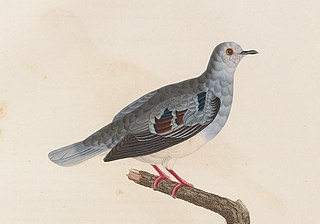
The purple-winged ground dove is a critically endangered species of dove, native to the Atlantic forest, mainly near bamboo, in south-eastern Brazil, far eastern Paraguay, and northern-eastern Argentina. It is threatened by habitat loss and possibly the wild bird trade, and could potentially even be extinct due to its specialized requirements.

Guaduas is a municipality and town in Colombia, in the Lower Magdalena Province department of Cundinamarca, about 117 km from Bogotá. It is an agricultural and tourist center of some importance with a population of about 33,000 in the municipality. Its name refers to a type of bamboo cane. It is one of the cities on the Bogotá-Medellín highway. Its main plaza is featured on the Colombian ten-thousand pesos bill, and is one of the seats of the Roman Catholic Diocese of La Dorada–Guaduas
Arthrostylidium is a Neotropical genus of climbing bamboo in the grass family. the species are native to Central America, the West Indies, northern South America, and southern Mexico.

Guadua is a Neotropical genus of thorny, clumping bamboo in the grass family, ranging from moderate to very large species.
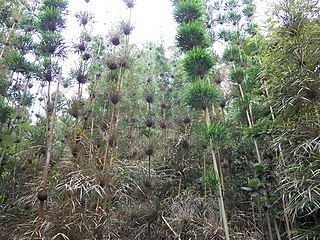
Nastus is a genus of slender, erect, scrambling or climbing bamboos in the grass family. It is native to Southeast Asia, Papuasia, and certain islands in the Indian Ocean.

Córdoba is a municipality in the eastern part of the department of Quindío, Colombia. It's located 24 km southeast of the departmental capital Armenia.
Oligoryzomys chacoensis, also known as the Chacoan colilargo or Chacoan pygmy rice rat, is a rodent species from South America. It is found in the Gran Chaco region of southeastern Bolivia, southwestern Brazil, Paraguay, and northeastern Argentina. Its karyotype has 2n = 58 and FNa = 74.

Policarpa Salavarrieta, also known by her nickname of La Pola, was a Neogranadine seamstress who spied for the Revolutionary Forces during the Spanish Reconquista of the Viceroyalty of New Granada. She was captured by Spanish Royalists and ultimately executed for high treason. The Day of the Colombian Woman is commemorated on the anniversary of her death. She is now considered a heroine of the independence of Colombia.

Lower Magdalena Province is one of the 15 provinces in the Cundinamarca Department, Colombia. Lower Magdalena borders to the west with the Magdalena River, the Departments of Tolima and Caldas, to the north with the Boyacá Department, to the east with the Rionegro Province and Gualiva Province, and to the south with the Central Magdalena Province.

The Pampas pipit, also known as the Chaco pipit or Campo pipit, is a species of bird in the family Motacillidae. It is found in Argentina and Paraguay. Its natural habitat is temperate grassland.

The big-headed pantanal swamp turtle or pantanal swamp turtle is a species of turtle in the family Chelidae found in Brazil, Bolivia, Argentina, and Paraguay.
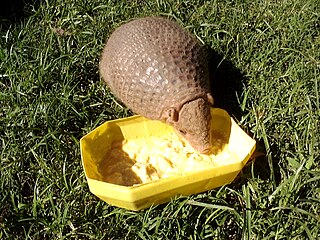
The Chacoan naked-tailed armadillo is a species of South American armadillo.

The Roman Catholic Diocese of La Dorada–Guaduas is a diocese located in the cities of La Dorada and Guaduas in the ecclesiastical province of Manizales in Colombia.
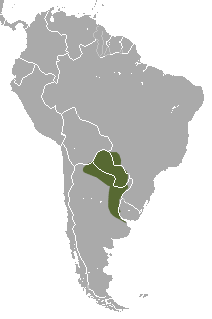
The chacoan gracile opossum is a species of opossum in the family Didelphidae. It is native to Argentina, Brazil and Paraguay. Its habitat is seasonally flooded grasslands and forests in and near the Gran Chaco.
The central leaf-eared mouse is a species of rodent in the family Cricetidae. It is known only from central Argentina. Prior to 1994, it was considered a subspecies of G. griseoflavus. Then referred to as G. centralis, as of 2019 it was referred to as G. chacoensis by the IUCN.
Bibimys chacoensis is a species of small rodent of the family Cricetidae living in the north-central part of Southern Cone of South America. The common name of this species is Chaco crimson-nosed rat. It is one of the three species currently recognized under the genus Bibimys.
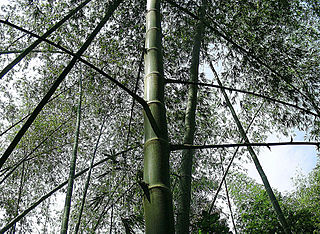
Guadua angustifolia also known as the Colombian timber bamboo and Colombian giant thorny, is a species of clumping bamboo found from Central to South America.

The Guaduas Formation (Spanish: Formación Guaduas, K2P1G, K2E1G, KPgg, KTg, TKg, Ktg) is a geological formation of the Middle Magdalena Basin and the Altiplano Cundiboyacense, Eastern Ranges of the Colombian Andes. The predominantly shale with coalbed formation dates to the Late Cretaceous and Paleogene periods; Maastrichtian-Paleocene epochs, and has a maximum thickness of 1,090 metres (3,580 ft). Fossils of Coussapoa camargoi, Ficus andrewsi, Berhamniphyllum sp. and Archaeopaliurus boyacensis have been found in coalbeds in Zipaquirá and Tasco, Boyacá.
Ximena Londoño de la Pava is a Colombian botanist, specializing in agrostology. She has done extensive research on the bamboo genus Guadua in South America and Central America.














